Top News
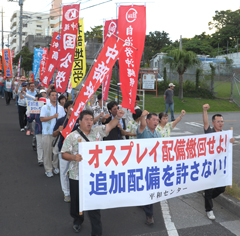
July 6, 2013 Ryukyu Shimpo
The Okinawa Peace Movement Center held a protest march on July 5 against the deployment of more Osprey to Okinawa, and has demanded the removal of the aircraft from the prefecture. About 60 people marched from Nodake Gate of U.S. Marine Corps Air Station Futenma in Ginowan to Ishihira Gate of Camp Foster in Kitanakagusuku.
The U.S. military plans to place 12 more MV-22 Osprey aircraft to Futenma Air Station at the beginning of August. Shouting, “Do not allow the U.S. military to bring more Osprey to Okinawa,” the marchers protested against the U.S. and Japanese governments forcing through this plan.
The center held the march to coincide with the protest action against stationing Osprey to Okinawa that they hold every Friday.
In the rally held in front of Nodake Gate before the march, the secretary-general of the center, Takashi Kishimoto said, “We are angry about the plan that the governments are forcing through. We must stand firm and denounce it. Sharing the anger of the Okinawan people, we will voice our protest.”
(English translation by T&CT, Mark Ealey)
Go to Japanese

Go To Video
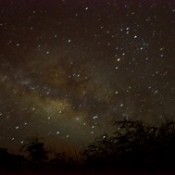
July 7, 2013 Ryukyu Shimpo
People in Kubura on Yonaguni Island saw the Milky Way in the southeastern sky the day before the Star Festival on July 7.
To the naked eye, the Milky Way looked like a white, blurry cloud extending from the southeastern to the eastern sky, but a camera using a long exposure captured it clearly.
The Milky Way is stars in the galaxy containing the solar system as viewed from the side.
The festival celebrates the meeting of the deities Orihime and Hikoboshi, as represented by the stars Vega and Altair. Legend has it that the Milky Way separates these lovers and they are only able to meet once a year.
Yonaguni Town held the International Billfish Tournament this day. In the evening, they held an event on a special stage set up on the water in Kubura Fishing Port.
(English translation by T&CT, Mark Ealey)
Go to Japanese
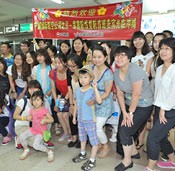
July 4, 2013 Ryukyu Shimpo
On July 3, Air China restarted its Naha-Beijing service that had been suspended from October 10, 2012 because of the Senkaku Islands dispute between Japan and China. At 7:00 p.m. that evening 136 people arrived at Naha Airport from Beijing and 59 people went to Beijing on the same airplane.
The Okinawa Convention and Visitors Bureau and others held a welcome ceremony at the arrival lobby in Naha Airport. Si-wei Ge, who is visiting Okinawa for the first time, said, “I came here on a friend’s introduction. I would like to see Shuri Castle and visit the areas around the U.S. military bases.”
To help promote Okinawan tourism, the bureau invited 12 people from seven media related companies, such as China Central Television and Beijing News. Shojin Heshiki, executive director of the bureau, stated, “The route is an important bridge between Beijing and Okinawa, and I hope it will promote exchange between the two regions.”
Air China runs two shuttle flights on the route every week on Wednesday and Saturday. Yi Yang, Okinawa branch manager of the company, said, “We resumed the service in the expectation of a demand for summer travel. About 70 percent of seats for travel in July and August are booked, which is good.”
Hainan Airlines suspended its Naha-Beijing service last September. China Eastern Airlines operates the Naha-Shanghai route, but Juneyao Airlines has postponed its new service on the route that was scheduled to start last September.
(English translation by T&CT, Lima Tokumori and Mark Ealey)
Go to Japanese
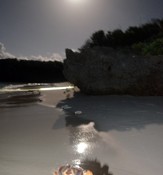
June 29, 2013
A species of terrestrial crab known as okagani came from inland on Ikema Island in Miyako to the coast to spawn on the night on June 23. That night the full moon, known as the “Super Moon,” looked much bigger and brighter than usual. With their eggs stuck on their bellies, the crabs moved down to the beach in the moonlight. They spawned their eggs by shaking their bodies in time with the movement of the waves. The crabs started to cross the road that runs around the island at nightfall on June 23. They risked their lives crossing the road before rushing to gather on the beach for spawning. When they had finished, the crabs went back up to the land.
Kaon Chinen, a second grader of Kita Elementary School, came to see the crabs. He said, “The waves flipped over some of the crabs that were spawning. They managed to get it done, so I hope that their young go well.”
(English translation by T&CT, Hitomi Shinzato and Mark Ealey)
Go to Japanese
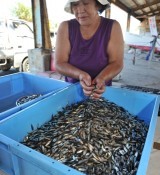
July 8, 2013 Ryukyu Shimpo
On July 8, which is June 1 in the lunar calendar, there was a good catch of suku fish on Ojima Island, Nanjo. Called suku in Okinawa, they are young rabbitfish, which are normally eaten salted. In the past people used to catch these fish over just a few days between June 1 and July 1 of the lunar calendar. The islanders and fishermen refer to the catch as a “bonus from the sea.”
People were excited about catching so many of these shining, silver fish between three and four centimeters long. At 9:30 a.m., the first fishing boat with about 15 kilograms of suku returned to port. Women busied themselves sorting the fish that their husbands and sons had caught.
(English translation by T&CT, Mark Ealey)
Go to Japanese

Go To Video
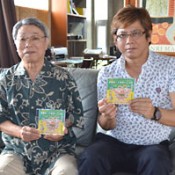
July 2, 2013 Ryukyu Shimpo
An Uchinaguchi educational CD entitled “Uchinaguchi Learning Beginning Level” became available on July 5 from made-in-okinawa.com. Okinawan actor Masao Hachiki appears in the CD and does the instruction. Similar to English language educational CDs, the approach is to learn Uchinaguchi by listening. It includes 140 shibai guchi words used in Okinawan drama.
Hachiki says, “You can learn the distinctive pronunciation and nuances of Uchinaguchi just by listening. I want young actors who don’t normally speak Uchinaguchi to make use of this CD.”
Representative of made-in-okinawa.com Yuji Haneji had attended Uchinaguchi classes in the past and was wondering if teaching materials existed for busy people. The project to create this CD started from there.
Haneji visited Hachiki to discuss the idea and the two immediately struck a chord.
Haneji said, “We must strive to preserve the correct Uchinaguchi that people in Mr. Hachiki’s generation speak.” The CD costs 1,500 yen including tax and is available in bookstores in Okinawa and online from the made-in-okinawa.com home page. An intermediate level version for conversational Uchinaguchi and an advanced level to learn about society and history will also be available for sale by August. For inquiries, please contact made-in-okinawa.com at 098 (879) 8370.
(English translation by T&CT, Megumi Chibana and Mark Ealey)
Go to Japanese
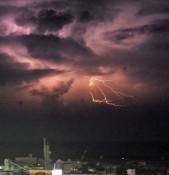
June 30, 2013 Ryukyu Shimpo
At 8:00 p.m. on June 29, the Ryukyu Shimpo received information from many readers that “An orange light is flashing in the sky.” People seemed worried as they looked at the light in the sky above U.S. military bases.
However, at 9:00 p.m., the Okinawa Meteorological Observatory identified the orange light as lightning from thunderclouds over the sea about 110 kilometers northwest of Naha. Residents could not hear the thunderclaps so far away from the land, but could see the lightning flashes because of the size of the thunderclouds.
(English translation by T&CT, Mark Ealey)
Go to Japanese
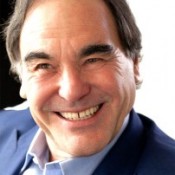
July 3, 2013 Ryukyu Shimpo
In an event that celebrates the 120th anniversary of the establishment of the Ryukyu Shimpo, the newspaper will invite two-time Academy Award-winning director Oliver Stone to Okinawa. The event will feature a lecture by Stone with a panel discussion. Stone will observe the U.S. military bases in Okinawa for the first time. With an interpreter present, the discussion will cover the excessive burden on Okinawa of hosting bases and U.S. military strategy. Some of the works of Stone and some digest footage of his visit to the prefecture will also be shown.
【Date】The event starts at 7:00 p.m. on Wednesday, August 14 with doors open from 6:30 p.m.
 Satoko Norimatsu |
 Masahide Ota |
 Peter Kuznick |
【Venue】Theater building of the Okinawa Convention Center in Ginowan
【Speaker and panelists】
Oliver Stone: American film director, screenwriter, producer and veteran
Peter Kuznick: Professor of History at American University
Masahide Ota: Former Okinawa Governor and director of the Ota Peace Research Institute
Satoko Norimatsu (panelist and interpreter): Director of the Peace Philosophy Centre
【Advance purchase tickets】Adults: 1,000 yen. Students up to and including university age: 500 yen (500 yen more if bought at the door)
Festival seating
【Ticket sales will begin】On July 4 Thursday
【Point of sale】 Ryukyu Shimpo newspaper company (Head office building, Izumizaki Branch Building and Central Region Office, Northern Region Office), all stores of Family Mart (Entertainment Plus) and Lawson (L code:88109), Junkudo Shoten Naha Branch and Todabooks Tomigusuku Branch, Kyuyodo Shobo (Naha Main Place Branch and San-A Nishihara City Mall Branch), Sakurazaka Theater.
【Contact】Ryukyu Shimpo Administration Office at 098(865)5200
【Organizer】Ryukyu Shimpo
【Cooperation from】Okinawa Television
Oliver Stone: American film director, screenwriter, producer and veteran. Stone was born in New York in 1946. After coming back from the Vietnam War, he graduated from New York University Film School. Stone debuted as a film director in 1974. He won Academy Awards for Best Director for films such as Platoon and Born on the Fourth of July. Stone has been energetically making films focused on contemporary and controversial American political and cultural issues such as JFK and Wall Street. He has created a documentary miniseries for Showtime titled The Untold History of the United States. It covers the hidden history of the United States after World War II and is attracting considerable attention.
Peter Kuznick: Professor of History at American University. Born in New York In 1948, Kuznick teaches modern history of the United States. A critic of the U.S. decision to use atomic bombs in World War II, he strongly criticizes U.S. military hegemonism. Kuznick brings American students to Hiroshima and Nagasaki every year. Teaching the course Oliver Stone’s America at the university, Kuznick and Stone prepared the series and book of the same title. These works represent a milestone in their collaborative projects.
Masahide Ota: Former Okinawa Governor and director of the Ota Peace Research Institute. Ota was born on Kumejima Island in 1925. Serving in the student unit called Tekketsu Kinnoutai, he barely escaped death while he was studying at teachers’ training school during the Battle of Okinawa. Ota graduated from Waseda University and Syracuse University where he earned a master’s degree in journalism. He served successively as a professor of Social Science and Dean of the Faculty Of Law and Letters in the University of the Ryukyus from 1957 to 1989. Ota became Okinawa Governor in 1990 and served two four-year terms. He then became a member of the upper house, serving one six-year term.
Satoko Norimatsu: Director of the Peace Philosophy Centre, a Vancouver-based organization promoting peace. Norimatsu actively publishes articles about the U.S. military base issue in Okinawa in both English and Japanese on the web. She and Gavan McCormack co-wrote a book titled Resistant Islands. Norimatsu also translated a book titled Rethinking the Atomic Bombings of Hiroshima and Nagasaki : Japanese and American Perspectives that was co-written by Kuznick and Akira Kimura. Norimatsu is a member of the 100 People Committee that seeks to create peace and recover human dignity in Okinawa.
(English translation by T&CT, Mark Ealey)
Go to Japanese
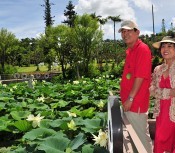
July 7, 2013 Ryukyu Shimpo
The Tonan Shokubutsu Rakuen (Botanical Garden) resumed operation on July 6 after being temporarily closed for renovations. Many people, including tourists and families from within and outside the prefecture, visited the park and enjoyed the more than 1,333 species of rare tropical and subtropical plants. On this sunny day, the garden has reopened for the first time in nearly two and a half years.
Okinawa City resident Tota Kinjo and his girlfriend were the first through the gate. “We came here early in the morning because we wanted to witness the moment when the lotus flower opens. We were impressed to see it for the first time in two and a half years,” said Kinjo excitedly.
Many visitors enjoyed the live events held after the opening ceremony.
(English translation by T&CT, Mark Ealey)
Go to Japanese
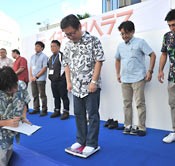
July 2, 2013 Ryukyu Shimpo
Ryukyu Shimpo, Okinawa Television Broadcasting and Radio Okinawa held a kick-off event for a dieting project on a stage set up in the open space in front of Palette-Kumoji Shopping Centre in Naha on July 1.
The companies named the project Ichikiro Herasu (Lose one kilogram of weight)! Its aim is to make Okinawan people aware of their health.
By using comedy skits and physical exercise, the companies are appealing to Okinawan people to reclaim the title of the prefecture with the highest longevity.
Ryukyu Shimpo President Junichi Tomita, Okinawa Television President Soko Machida and Radio Okinawa President Akira Morita revealed the project title.
Representing the three companies, Tomita said, “We hope that by providing information about eating habits and effective exercise we can help reclaim our position as the prefecture with the highest longevity.”
As part of the project, nine employees from the companies took part in a dieting competition.
(English translation by T&CT, Mark Ealey)
Go to Japanese
July 2, 2013 Ryukyu Shimpo
The Ministry of Defense announced on July 1 that the U.S. Marine Corps will send 12 additional MV-22 Osprey aircraft to U.S. Iwakuni Air Station, Yamaguchi, from July 28 to 31. The vertical take-off and landing transport aircraft will be deployed to U.S. Marine Corps Air Station Futenma in early August after a week of maintenance and flight tests in Iwakuni.
Okinawa Governor Hirokazu Nakaima has made his opposition clear. He will visit Tokyo after the regular meeting of the assembly to ask the central government to cancel the plan.
Toshinori Tanaka, director of the Okinawa Defense Bureau, explained the plan to the Ginowan City authorities and the Okinawa Prefectural Government (OPG) on July 1. However, he did not reveal the specific timing involved. Tatsuo Oyakawa, deputy director general of military affairs in the OPG, said, “We have asked the government to rethink the plan and to send the aircraft in other prefectures.”
Parliamentary Vice-Minister of Defense Akira Sato visited Iwakuni Mayor Yoshihiko Fukuda and Yamaguchi Governor Shigetaro Yamamoto to request their understanding regarding the aircraft coming to Iwakuni. Governor Yamamoto responded saying, “Local residents’ concerns have not been resolved.” He asked the vice-minister to have the U.S. military provide appropriate information on the flights. The governor also requested an early end to the Osprey’s operation in Iwakuni and that the U.S. military adhere to the agreement by the Japan-U.S. Joint Committee on time and altitude for flights.
Mayor Fukuda commented, “It’s disappointing, but we have been told that this will
lead to a reduction of the burden on Okinawa, so to a certain extent we understand.”
This additional Osprey deployment will complete the plan to replace the CH-46 helicopters at the Futenma base with MV-22.
The Okinawa Prefectural Assembly and 41 municipalities delivered a petition requesting the cancellation of the Osprey’s deployment to Prime Minister Shinzo Abe in January. On June 12, the Governor and mayors of the municipalities that host U.S. military bases asked the Prime Minister to cancel the plan, saying, “Our concerns over the aircraft’s safety have not been resolved.”
(English translation by T&CT, Mark Ealey)
Go to Japanese















 Webcam(Kokusai Street)
Webcam(Kokusai Street)


